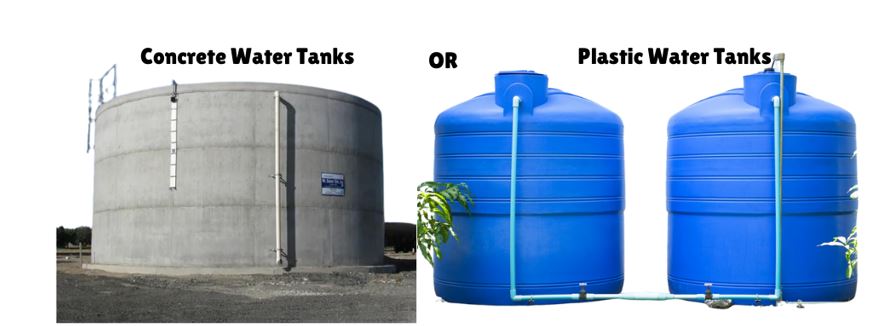The Benefits of Using Plastic Water Tanks vs. Concrete Water Tanks
Introduction
Water storage is an important part of construction. Usually, water tanks are installed on top of every house, where it has to withstand extreme temperatures, especially in a country like Pakistan. All homeowners are quite keen on the water tank installation at their homes.
The choice of water tank is between a plastic one and a concrete one. Homeowners often remain confused about the choice, which is why we are writing this blog to explain both types in detail. Read this blog to learn about both types’ advantages, disadvantages, and installation costs.
Plastic Water Tanks
What Are Plastic Water Tanks?
Plastic water tanks come in different shapes and sizes and have versatile compositions. They are usually made from High-Density Polyethylene (HDPE) or another similar material. They come in various sizes depending on the storage requirements of the house.
Advantages of Plastic Water Tanks
1). Lightweight and Easy Installation
The most important benefit of plastic tanks is their lightweight and simple installation procedure. Due to the usage of HDPE, they don’t have enough weight and can be easily carried from the shop to your house and then on the top. Moreover, the installation is quite simple and can be carried out by only one or two people.
2). Cost-Effective
Plastic tanks are available in the market at quite low prices depending on the material and size. If you are budget-tight during construction, plastic water tanks are available for you at lower rates. They also have quite a lower installation cost compared to concrete tanks.
3). Durability and Longevity
Plastic tanks are made from HDPE material, which is highly durable and has the ability to longstand. They can bear the extreme temperature both during the summer and winter seasons. Also, there is no tension of getting rusty, and they can serve the purpose for many years.
4). Low Maintenance
Plastic tanks do not require specific maintenance because they are resistant to algae and other plant growth. You can use them for longer periods of time without investing in their maintenance.
Disadvantages of Plastic Water Tanks
1). Temperature Sensitivity
Plastic water tanks are highly sensitive to temperature. Especially during the summer season in Pakistan, the water inside the plastic tanks gets extremely hot, which may not be used by residents during the day. High temperatures also affect their longevity.
2). Potential for Chemical Leaching
If you use a plastic water tank made of low-quality plastic, there are strong chances of chemicals leaching into the water. The best practice is to go for a plastic water tank made of good material.
Concrete Water Tanks
What Are Concrete Water Tanks?
Reinforced concrete is used to make concrete water tanks. They are famous for their strength, durability, and longevity. Moreover, they also offer you the flexibility to make a water tank as big as you want, depending on your daily requirements.
Advantages of Concrete Water Tanks
1). Robustness and Strength
As they are made using concrete, they are stronger than plastic water tanks. Moreover, they have more capacity to bear pressure and stress. They are quite good for areas with extreme temperatures and where the requirement for water is higher.
2). Temperature Stability
Concrete water tanks offer very good temperature stability. Even during extreme cold or heat, the temperature of the water inside them stays quite stable. This characteristic makes them highly useful for regions like Pakistan with extreme temperatures.
3). Long Lifespan
Concrete tanks are famous for their strength and longevity. They are a one-time investment during construction, after which they continue to facilitate you for a longer period of time. Because they are made of concrete, they don’t erode easily.
Disadvantages of Concrete Water Tanks
1). Heavy and Difficult to Install
Water tanks are generally installed at the top of the house in Pakistan, requiring all the materials, including concrete and other construction equipment. Furthermore, professional services are also required to install this water tank.
2). Higher Cost
Concrete tanks require a one-time investment during the construction process. You will pay much more compared to plastictanks, but once installed, they will last for many years.
3). Maintenance Requirements
Another disadvantage of using concrete water tanks is that they require ongoing monitoring and maintenance. Algae growth inside or outside them can be a problem, which should be tackled at the right time to prevent concrete erosion.
Conclusion
The best choice between plastic and concrete tanks depends on your specific needs and circumstances. Plastic tanks are cost-effective, easy to install, and low maintenance, making them ideal for residential and smaller-scale applications. With their robustness and temperature stability, concrete tanks are better suited for large-scale storage and regions with extreme weather conditions.
Ultimately, both types of tanks have advantages and disadvantages. By considering installation ease, cost, maintenance, environmental impact, and climate suitability, you can decide to meet your water storage needs best.
FAQs
How long do plastic tanks last?
Plastic water tanks have good longevity and can last a minimum of 5 to 10 years.
Are concrete water tanks safe for drinking water?
Yes, they are safe, but this can be achieved only if the water tank is maintained properly and extensive measures are taken to ensure its cleanliness.
Can plastic tanks be used for rainwater harvesting?
Yes, plastic water tanks are the optimal option for rainwater harvesting. They can be installed easily anywhere on your roof.
What are the main factors when choosing between plastic and concrete tanks?
Key factors include cost, installation process, maintenance requirements, environmental impact, and the specific climate where the tank will be used.
How do I maintain my tank to ensure longevity?
Regular cleaning and avoiding exposure to extreme temperatures can help maintain the longevity of plastic tanks. Periodic inspections and repairs are essential for concrete tanks to prevent cracking and ensure they remain waterproof.



